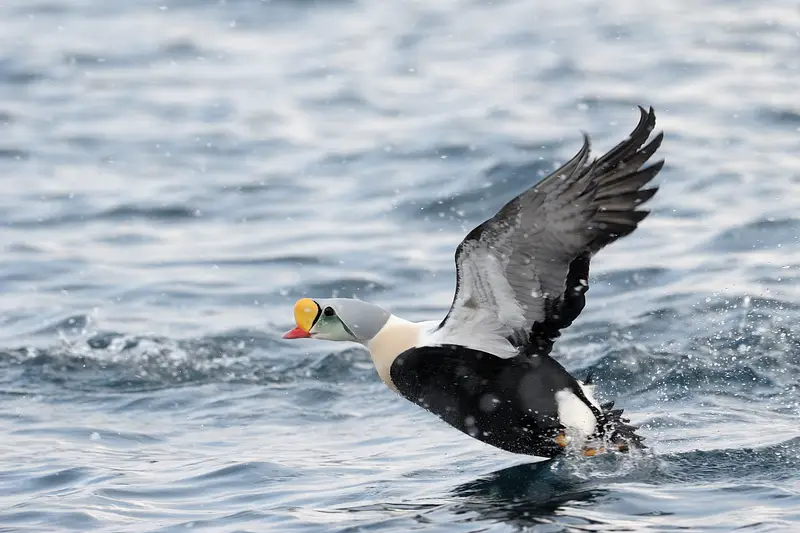About King Eider
King Eiders (Somateria spectabilis) are one of the most spectacular and enigmatic sea ducks, known for their striking plumage and extreme Arctic habitats. These diving ducks pose unique challenges for GPS tracking due to their remote lifestyle, often spending most of their lives far out of reach of cell service, the main method for transmitting GPS data. This necessitates the use of Argos satellite tags, a much more expensive option. Additionally, diving ducks, along with cavity-nesting ducks, cannot be fitted with backpack harnesses like dabbling duck species, leaving scientists to use implantable devices or tags designed to fall off after a period. The GPS tracking data from these early trackers available on the 50 Ducks platform reveals a remarkable yet incomplete journey of these fascinating creatures. Advances in implantable technologies are paving the way for better understanding these birds in future studies.

Identification
King Eiders are easily identifiable by their large size and distinctive plumage. Males have strikingly colorful plumage with a bright orange bill, a light blue crown, and a greenish nape. Their bodies are predominantly black with white patches on the chest and back. Females are more subdued in coloration, with mottled brown plumage that provides excellent camouflage in their nesting environments. Both sexes have a unique, bulbous structure at the base of the bill, adding to their distinctive appearance.
Breeding
King Eiders breed in the high Arctic, selecting coastal wetlands, ponds, and lakes for nesting. The female builds a nest on the ground, often concealed by vegetation, and lines it with down feathers. She lays a clutch of 4-7 eggs and is solely responsible for incubation.
Behavior
King Eiders exhibit remarkable endurance and adaptability, often thriving in extreme Arctic conditions. During the breeding season, males perform elaborate courtship displays, using their vibrant plumage and unique vocalizations to attract females. These ducks are also known for their strong site fidelity, often returning to the same breeding and wintering areas year after year.
Habitat
King Eiders breed in the remote Arctic tundra, preferring coastal wetlands, ponds, and lakes for nesting. During the winter, they migrate to coastal marine environments, often found in the icy waters of the North Atlantic and North Pacific Oceans. They are well-adapted to these harsh conditions, frequently seen in areas with sea ice and strong currents.
Migration
King Eiders undertake long and arduous migrations between their breeding and wintering grounds. They breed in the high Arctic, including regions of Alaska, Canada, and Greenland, and migrate to wintering areas along the coasts of northern Europe, Russia, and North America.
No Data Found
How many days tracked
Lorem ipsum dolor sit amet, consectetur adipiscing elit. Ut elit tellus, luctus nec ullamcorper mattis, pulvinar dapibus leo.
Where are they now?
Lorem ipsum dolor sit amet, consectetur adipiscing elit. Ut elit tellus, luctus nec ullamcorper mattis, pulvinar dapibus leo.
No Data Found
No Data Found
Total Number of Data Points for King Eider
Lorem ipsum dolor sit amet, consectetur adipiscing elit. Ut elit tellus, luctus nec ullamcorper mattis, pulvinar dapibus leo.
Start and End Date Tracking of King Eider
Lorem ipsum dolor sit amet, consectetur adipiscing elit. Ut elit tellus, luctus nec ullamcorper mattis, pulvinar dapibus leo.
No Data Found
Overall Data from the Center
This is historical data from various sources. This data is available in its full form on our Duck Map in an easily visualizable format.
